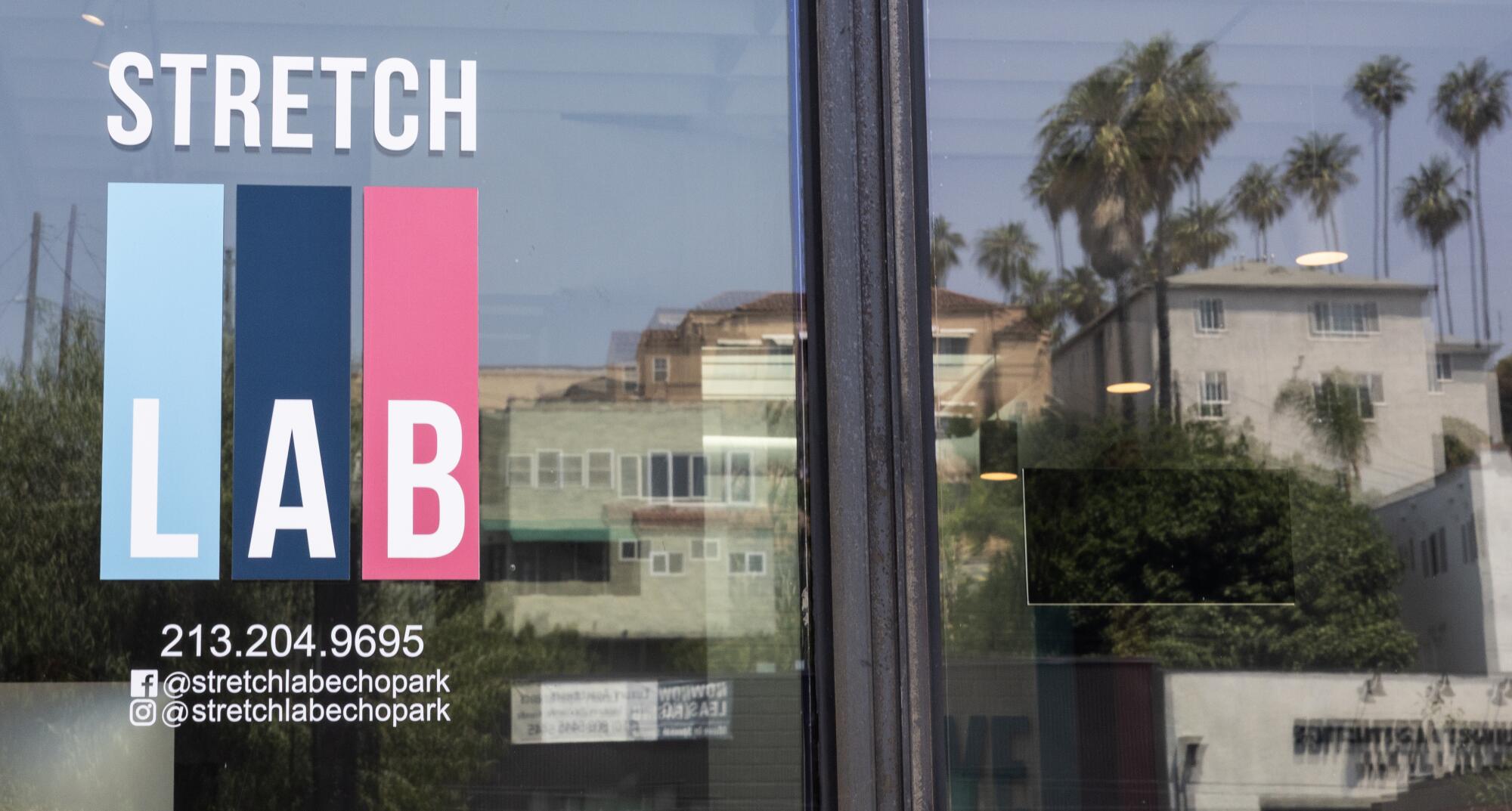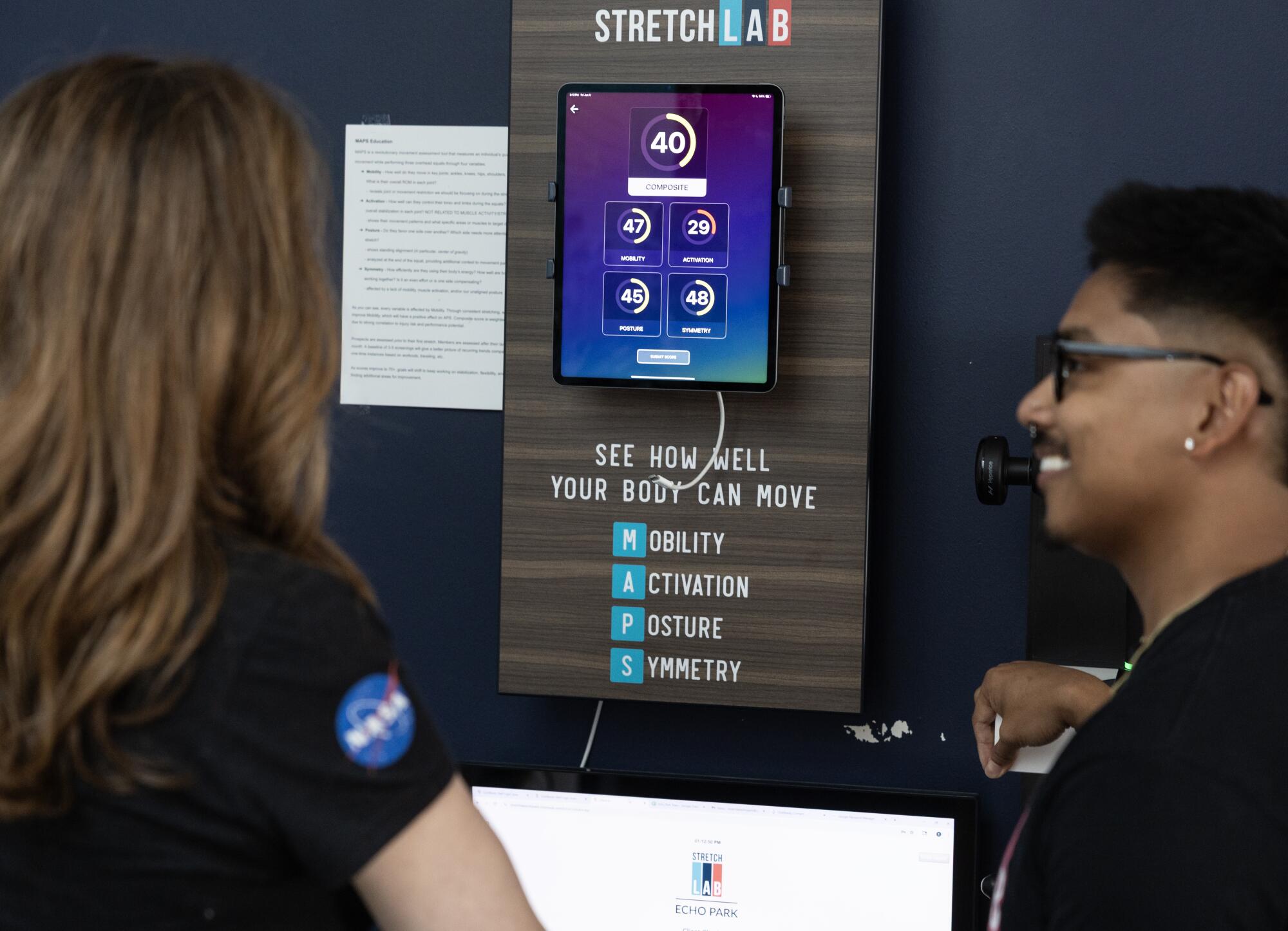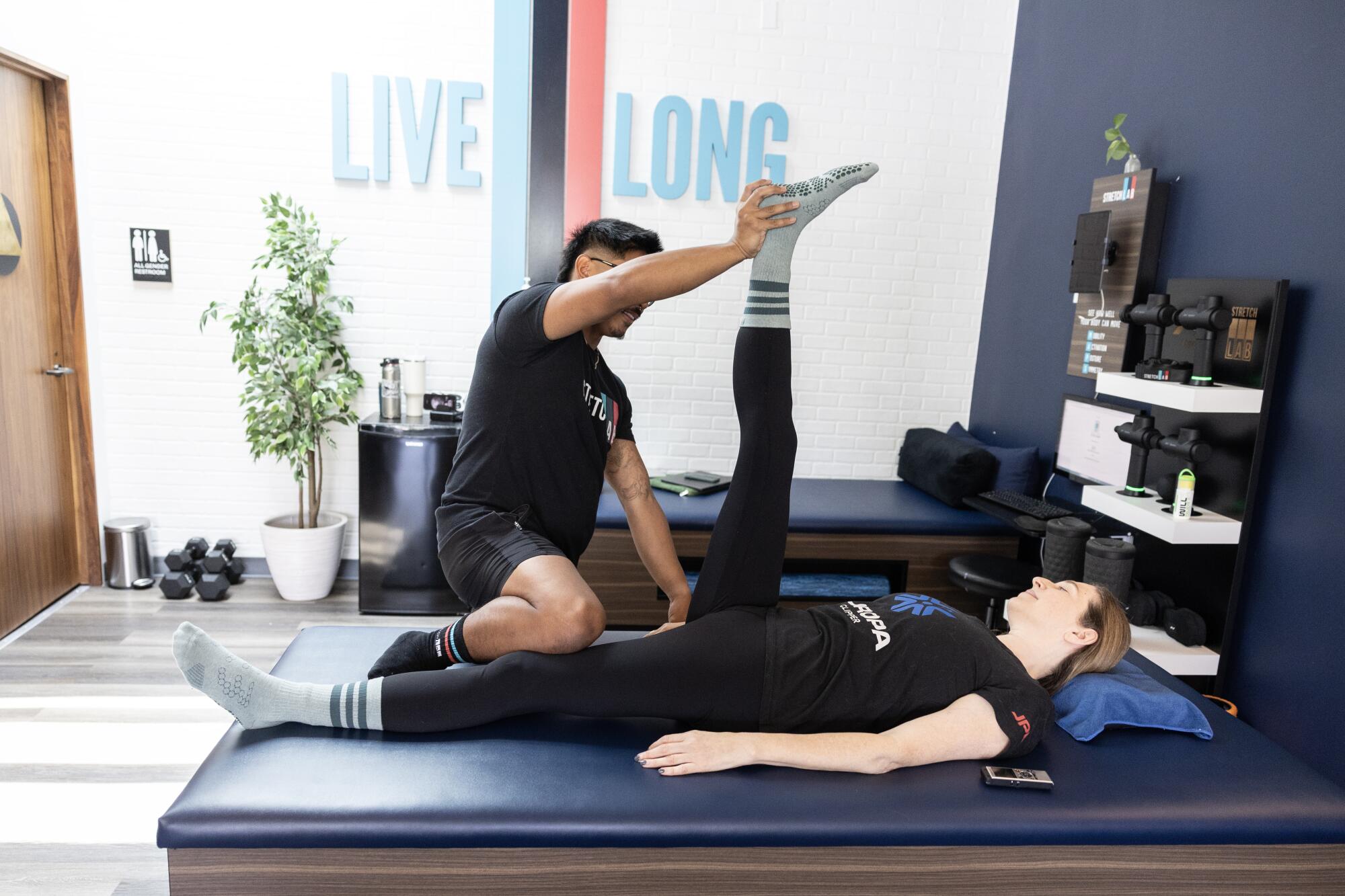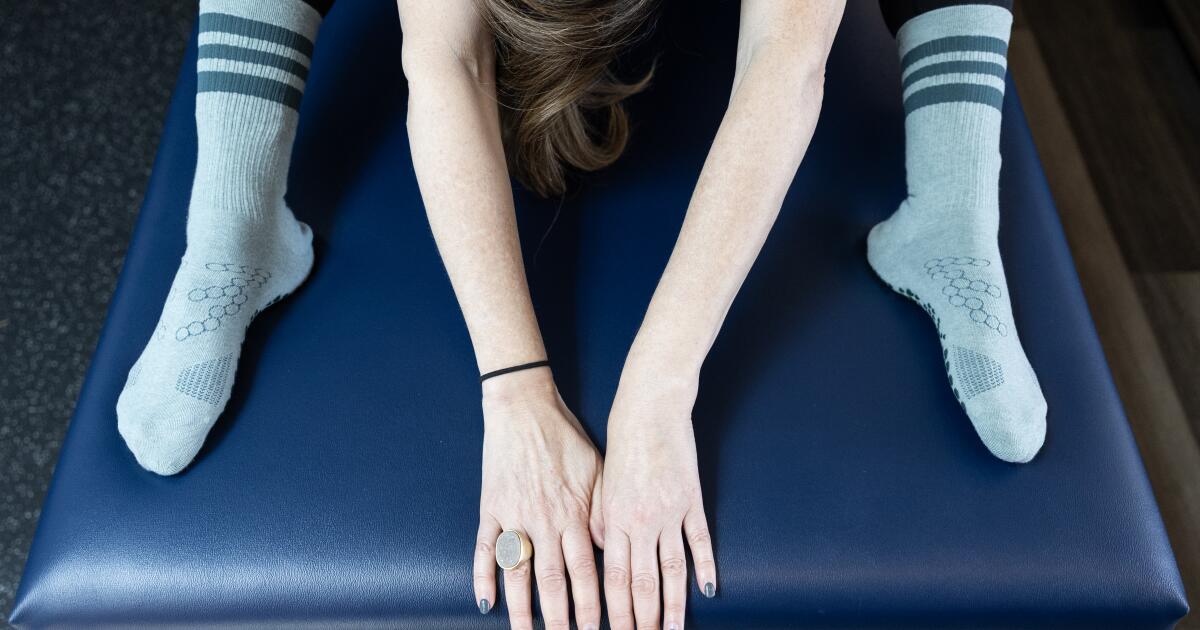The signs seemed to be proliferating around Los Angeles — along Sunset Boulevard in Echo Park, in mini-malls on Pacific Coast Highway, on side streets in Glendale and Venice: StretchLab, Stretch Zone, StretchSPOT, StretchMed.
Deborah Vankin’s 50-minute stretch session included 13 stretches on either side of her body.
(Luke Johnson / Los Angeles Times)
I’d been curious about assisted stretching for a while. But I never thought to visit a studio. Sure, “recovery” is a growing trend in fitness — meaning rejuvenating muscles, tendons and the central nervous system between exercise sessions by focusing on hydration, proper nutrition, sleep and, yes, active stretching so as to maximize athletic performance. But I own three foam rollers — one smooth, one spiky, one padded — and even use them at home. I’m also far from an extreme athlete, preferring instead brisk hikes for cardio and basic strength training.
Why would I drive to a mini-mall and pay someone to stretch me? What would that even look like — and was it worth it?
The questions rumbled in my head as I drove past yet another StretchLab recently — this one on Beverly Boulevard near Hollywood. So I called them up.

StretchLab has 15 locations in the L.A. area, including in Echo Park.
(Luke Johnson / Los Angeles Times)
Turns out StretchLab, which opened its first studio in Venice in 2015, now has more than 500 studios nationwide, 15 of them in the L.A. area. Its clientele are generally either serious athletes, older adults and desk workers who struggle with stiffness and want to work on their mobility, or those healing injuries and other conditions. They come to be stretched out more deeply, in positions they couldn’t possibly get into, physically, on their own. Many of them appreciate the intimacy and accountability of working with a practitioner, one-on-one. And it can be helpful to have a professional, with a trained eye, isolate asymmetries in their bodies and guide their stretching, especially for those who suffer from chronic pain or are healing an injury, says StretchLab‘s director of marketing, Gabi Khowploum.
“We see a lot of people who say, ‘Hey, I’m having back pain,’” Khowploum says. “And they come to stretch it, but it might be they’re having issues with hip mobility — they just don’t realize it.”
Stretch therapists — or “flexologists,” as they’re sometimes called — are not doctors. Chiropractors, physical therapists and some massage therapists are trained in assisted stretching — but stretch therapists can’t do what they do. Stretch therapists don’t diagnose and treat injuries; they don’t provide spinal or joint manipulation, imaging such as X-rays or CT scans or massage. They focus, instead, on stretching muscles and fascia to increase flexibility and mobility. There also isn’t a national certification for stretch therapists, as there is for physical therapists and chiropractors, though most stretch therapists are certified in-house by their respective employers.
Dr. Jeremy Swisher, a sports medicine physician at UCLA Health, says assisted stretching can help increase range of motion and flexibility, stimulate blood flow, which aids healing, and help with posture, particularly for sedentary populations, as well as alleviate stress. Done consistently, long term, it can help with pain relief and stiffness and — possibly — prevent injuries. But it’s “not a cure-all,” he warns.
“It’s just a piece of the puzzle,” he says. “Strength training and other forms of exercise are equally as important, long term.” Swisher also warns that assisted stretching could exacerbate existing injuries “like an acute sprain or tear without being cleared by a doctor first.” And for those with hypermobility syndromes, meaning overly flexible joints, “it’s important to be mindful that increased stretching could lead to dislocations of the joints.”
On a recent Friday afternoon, StretchLab in Echo Park was busier than I would have expected. Several clients laid on their backs on what looked like massage tables as their flexologists rolled or twisted or pressed on their body parts — a limb over the shoulder here, a spinal twist there.

Flexologist Joel Badilla walks Deborah Vankin through the MAPS assessment process.
(Luke Johnson / Los Angeles Times)
My practitioner, Joel Badilla, walked me through the assessment before my 50-minute session (as a “drop in,” it cost me $125, but prices differ depending on the package and location). StretchLab uses a 3-D body scanning tool called MAPS, which TRX Training developed for them. It assesses mobility (range of motion), activation (quality of movement), posture and symmetry so as to isolate areas that are tight or imbalanced and customize a stretch program for the client. I did three overhead squats in front of an iPad before MAPS gave me a score in each area. (Scores far lower than I would have liked, the culprits being tight hips and “tech neck,” but such is the case with desk workers, I was told.)
Then I laid down on the table and Badilla lifted my legs and gently pulled them forward, toward him. It felt wonderful, as if my spine were elongating, all the stress draining from my back. He then put me through 26 stretches, 13 on each side of my body.

Joel Badilla tugs gently on Deborah Vankin’s legs at the start of her stretch session.
(Luke Johnson / Los Angeles Times)
StretchLab uses PNF stretching (proprioceptive neuromuscular facilitation), Badilla explained, which is a “push and release” technique. The recipient holds the stretch for a set period of time, then pushes into resistance provided by the practitioner for a shorter period of time, then goes back into a deeper version of the stretch. We did this repeatedly for different body parts.
Afterward, I felt loose and limber heading back to my car — though the sensation didn’t last for very long after my car ride home. That’s because the benefits of stretching come from consistency, says Amber Donaldson, vice president of Sports Medicine Clinics for the United States Olympic & Paralympic Committee.
“Just stretching once isn’t beneficial,” she says. “You need two weeks, minimum, of consistency to see a benefit. These [assisted stretching] places — paying for a series of treatments may keep you consistent with going.”
That said, there are questions around the benefits of stretching, overall, in the sports medicine community, Donaldson adds. “It’s controversial. When should you do it — before or after a workout — and to what extent is it beneficial at all? The jury is still out.”

Assisted stretching, if done consistently over many weeks, may help with stiffness, pain relief and even injury prevention.
(Luke Johnson / Los Angeles Times)
StretchLab is far from an anomaly in L.A. There are more than half a dozen dedicated assisted stretching businesses in the area — and the trend, which began to swell nationwide in 2017-18, only seems to be growing. In addition to franchises like StretchLab and Stretch Zone, many personal trainers offer assisted stretching, as do most physical therapists. Gyms such as Life Time in Orange County and the Los Angeles Athletic Club offer one-on-one assisted stretching now. Even certain massage outlets, such as Massage Envy, offer 30 and 60-minute assisted stretching sessions.
The basic concept of assisted stretching is the same, no matter where you go, but different studios take slightly different approaches.
Stretch Zone in Redondo Beach and Rancho Palos Verdes doesn’t use the PNF technique. Instead, the studio (which has almost 400 outlets nationwide) uses a graduated stretch modality that moves the client along an intensity scale of one-10. It starts at a three “right when you first start to feel the stretch,” owner Deborah Ashley says, “and seven is where you want us to stop.” They also use a patented system of belts and straps on a stretch table “to secure and mobilize one side of your body while we stretch the other,” Ashley says. “It acts like a second set of hands for our practitioners.”
StretchMed in Glendale has only one location in the L.A. area (there are about 30 in the U.S.). It prides itself on not being part of an especially big franchise, says owner Carlos Rivera, adding that the studio takes a personal and data-driven approach to stretch therapy. It does use the PNF stretching technique but puts a good deal of emphasis on warming up before one-on-one stretch sessions. Toward that end, clients do 15-minute warm-up routines on so-called “stretch trainers,” which have tilted seats, leg pads and safety straps for stability. A video walks them through the routine, which includes gentle movement and is meant to stimulate circulation. “You want to warm up before you stretch,” Rivera says, “to get a much better benefit.”
Would I do assisted stretching again?
Absolutely — it was gentler than I imagined and I felt immediate relief afterward, particularly in my lower back.
Would I do it regularly?
Not for StretchLab’s membership rate of $320 a month, their cheapest monthly package of four 50-minute sessions (prices vary slightly by location). At Stretch Zone, the roughly comparable package of four 60-minute sessions is $400. At StretchMed, four 55-minute sessions is $216.
But on this particular Friday, at least, I headed into the weekend feeling looser and, if nothing else, an inch or so taller. I’ll take it.
This story originally appeared on LA Times

